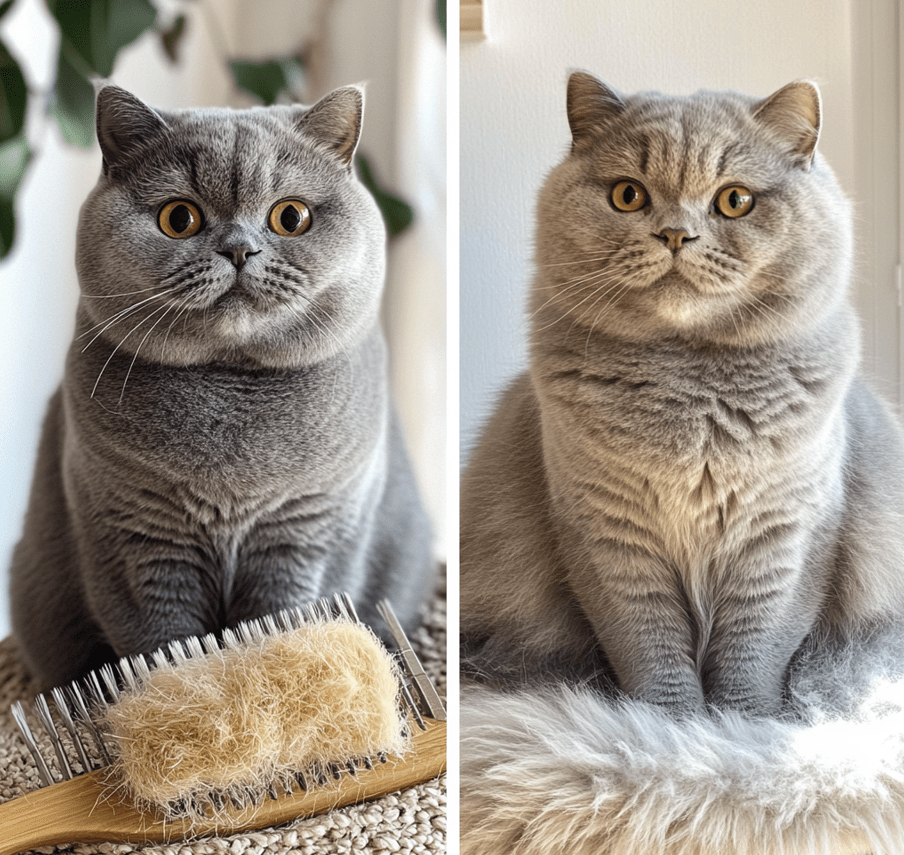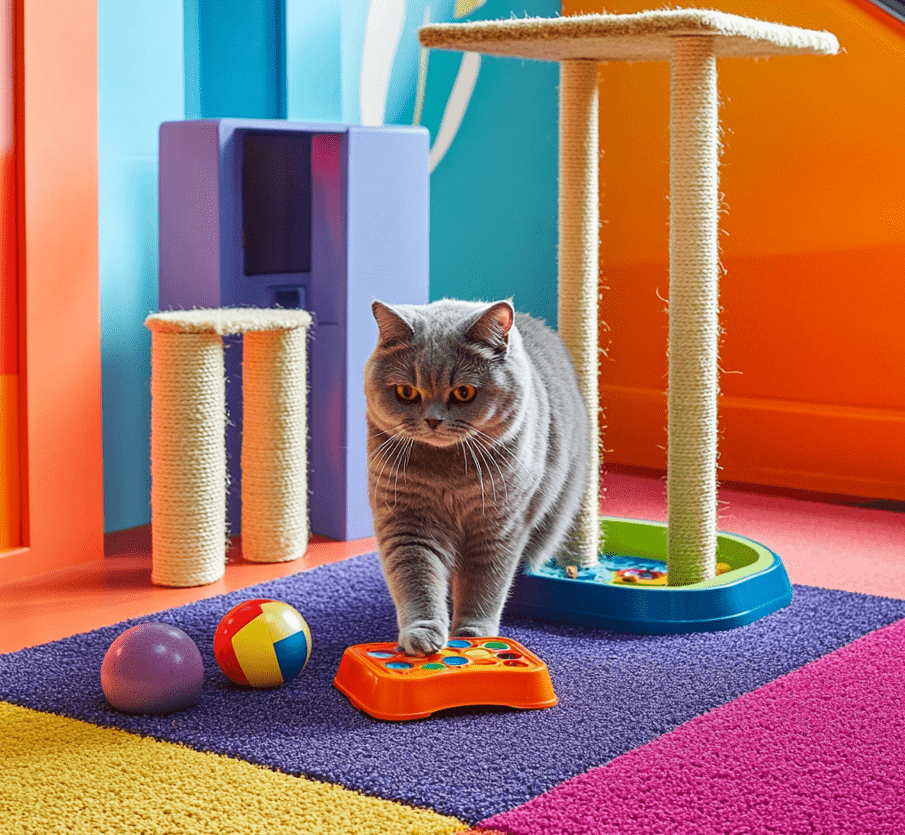
British Shorthairs, with their plush, dense coats, are prone to shedding, which can leave fur on furniture and clothing. Learning how to reduce shedding in British Shorthair cats is essential for keeping your home clean and your cat comfortable without resorting to excessive grooming that could harm their skin or coat. This comprehensive guide provides practical, vet-approved strategies to manage shedding effectively while maintaining your British Shorthair’s health and happiness. From diet tweaks to grooming techniques, discover how to tackle shedding year-round without overdoing it.
Why British Shorthairs Shed
Shedding is a natural process for all cats, including British Shorthairs, as they replace old or damaged fur with new growth. However, their thick, double-layered coat makes shedding more noticeable, especially during seasonal transitions. Understanding the causes of shedding helps you address it effectively without over-grooming, which can strip natural oils or irritate the skin.
Common Causes of Shedding
Seasonal Changes: Heavy shedding occurs in spring and fall as the coat adjusts to temperature shifts.
Diet and Nutrition: Poor diet can lead to excessive shedding or dull fur.
Stress: Environmental changes or anxiety can trigger fur loss.
Skin Health: Allergies, infections, or parasites like fleas can increase shedding.
Hormonal Changes: Spaying/neutering or aging can affect coat turnover.
By targeting these factors, you can reduce shedding in British Shorthair cats while keeping grooming gentle and balanced.
The Risks of Over-Grooming
Over-grooming, such as excessive brushing or frequent baths, can do more harm than good. It’s important to strike a balance to avoid these pitfalls:
Skin Irritation: Over-brushing can cause redness, dryness, or micro-abrasions.
Oil Depletion: Frequent bathing strips natural oils, leading to flaky skin and increased shedding.
Stress: Forcing grooming sessions can make your cat anxious, worsening fur loss.
Coat Damage: Harsh tools or aggressive brushing can break healthy hairs.
This article focuses on gentle, effective methods to reduce shedding in British Shorthair cats without crossing into over-grooming territory.
Effective Strategies to Reduce Shedding in British Shorthairs
Below are vet-approved, practical approaches to manage shedding while keeping your British Shorthair’s coat and skin healthy. These strategies emphasize minimal grooming with maximum impact.

1. Optimize Your Cat’s Diet
A balanced diet is the foundation for a healthy coat and reduced shedding. Poor nutrition can lead to excessive fur loss, while the right nutrients support strong, healthy hair.
Key Nutrients:
Omega-3 and Omega-6 Fatty Acids: Found in fish oil or flaxseed, these promote a glossy coat and reduce shedding.
High-Quality Protein: Supports hair growth, as fur is primarily made of keratin.
Vitamins and Minerals: Biotin, zinc, and vitamin E strengthen hair follicles.
Action Steps:
1.Feed a premium, vet-approved cat food formulated for skin and coat health.
2.Add a vet-recommended supplement, like fish oil, if shedding persists.
3.Ensure constant access to fresh water to prevent dehydration-related skin issues.
Tip: Transition to new foods gradually over 7–10 days to avoid digestive upset.
2. Brush Smart, Not Hard
Regular brushing is essential to reduce shedding in British Shorthair cats, but it must be done correctly to avoid over-grooming. The goal is to remove loose fur without irritating the skin.
How Often: Brush 1–2 times per week during low-shedding seasons (summer/winter) and 2–3 times per week during high-shedding seasons (spring/fall).
Best Tools:
Slicker Brush: Gently removes loose fur and prevents matting.
De-shedding Tool: Ideal for heavy shedding periods, used sparingly.
Grooming Glove: Perfect for sensitive cats or light shedding.
Technique:
1.Brush in the direction of hair growth with gentle, even strokes.
2.Focus on high-shedding areas like the back, sides, and tail base.
3.Stop if your cat shows signs of discomfort, such as twitching or vocalizing.
Tip: Keep sessions short (5–10 minutes) and reward your cat with treats to make brushing a positive experience.
3. Bathe Sparingly with Care
Bathing can help remove loose fur and allergens, but over-bathing can dry out the skin, leading to more shedding. Use baths strategically to reduce shedding in British Shorthair cats.
How Often: Bathe every 6–8 weeks, or less if your cat stays clean indoors.
Products:
1.Use a cat-safe, hypoallergenic shampoo designed for sensitive skin.
2.Avoid human shampoos or products with harsh chemicals.
Technique:
1.Use lukewarm water and a non-slip mat to keep your cat calm.
2.Rinse thoroughly to prevent residue that could irritate the skin.
3.Dry completely with a towel or low-heat pet dryer to avoid moisture-related issues.
Tip: If bathing is stressful, use pet-safe grooming wipes for spot cleaning instead.
4. Control Fleas and Parasites
Fleas, ticks, and mites can cause itching, leading to excessive grooming and shedding. Effective parasite control is key to minimizing fur loss.
Action Steps:
1.Apply a vet-approved flea preventative monthly, even for indoor cats.
2.Use a flea comb weekly to check for signs of fleas or flea dirt (black specks).
3.Vacuum carpets, furniture, and bedding regularly to eliminate flea eggs.
Signs of Parasites:
1.Intense scratching, especially around the neck or tail base.
2.Small red bumps or hair loss in affected areas.
Tip: Consult your vet immediately if you suspect parasites, as they can lead to skin infections.
5. Manage Environmental Allergens
Allergens like pollen, dust, or mold can irritate your British Shorthair’s skin, triggering scratching and shedding. Reducing exposure helps keep the coat healthy.
Action Steps:
1.Wash your cat’s bedding weekly in hot water to remove dust and dander.
2.Use an air purifier to minimize airborne allergens.
3.Keep your cat indoors during high-pollen seasons (spring/fall).
Grooming Tip:
Wipe the coat with a damp cloth or pet-safe wipe after outdoor exposure to remove allergens.
Tip: Monitor for signs of atopic dermatitis, such as licking paws or red skin, and consult a vet if symptoms appear.
6. Reduce Stress
Stress can cause excessive shedding in British Shorthairs, as it disrupts the hair growth cycle. A calm environment supports a healthy coat.
Common Stressors:
1.Changes in routine, like moving or new pets.
2.Loud noises or lack of safe spaces.
3.Inconsistent feeding or litter box maintenance.
Action Steps:
1.Provide a quiet, cozy space with a bed or hiding spot.
2.Use interactive toys or puzzle feeders to keep your cat mentally stimulated.
3.Maintain a consistent daily routine for feeding, play, and grooming.
Tip: Consider pheromone diffusers (e.g., Feliway) for anxious cats, but consult your vet first.
7. Support Skin Health
Healthy skin is the foundation for a healthy coat. Dry, flaky, or irritated skin can increase shedding, so proactive care is essential.
Action Steps:
1.Use a pet-safe moisturizing spray or conditioner for dry skin, especially in winter.
2.Check for signs of skin issues, like redness or scabs, during grooming.
3.Add a humidifier to your home to combat dry air from indoor heating.
Tip: If you notice persistent skin changes, schedule a vet visit to rule out allergies or infections.
Seasonal Considerations for Shedding
Shedding patterns in British Shorthairs vary by season, requiring tailored strategies to reduce shedding in British Shorthair cats year-round.

Spring and Fall: Heavy Shedding Seasons
Challenge: British Shorthairs shed their winter coat in spring and summer coat in fall, leading to significant fur loss.
Tips:
1.Increase brushing to 2–3 times per week with a de-shedding tool.
2.Vacuum your home frequently to manage loose fur.
3.Monitor for skin irritation, as allergens are high during these seasons.
Summer: Light Shedding
Challenge: Heat and humidity can cause skin issues, indirectly increasing shedding.
Tips:
1.Brush 1–2 times per week to promote airflow and prevent matting.
2.Keep the coat dry to avoid bacterial growth.
3.Ensure your cat stays cool with access to shaded areas or fans.
Winter: Moderate Shedding
Challenge: Dry air and indoor heating can lead to flaky skin, contributing to shedding.
Tips:
1.Brush 1–2 times per week to distribute natural oils.
2.Use a humidifier to maintain skin moisture.
3.Check paw pads for cracking due to cold surfaces.
Essential Tools to Reduce Shedding
Having the right grooming tools makes it easier to reduce shedding in British Shorthair cats without overdoing it. Here’s what you need:
Slicker Brush: Removes loose fur and prevents matting.
De-shedding Tool: Targets undercoat during heavy shedding seasons.
Grooming Glove: Gentle option for daily maintenance or sensitive cats.
Flea Comb: Detects parasites and removes debris.
Pet-Safe Wipes: Cleans allergens or dirt without bathing.
Nail Clippers: Prevents scratching during grooming.
Common Myths About Shedding in British Shorthairs
Misconceptions about shedding can lead to ineffective or harmful practices. Let’s debunk some myths:
Myth: Shaving reduces shedding permanently.
Truth: Shaving can damage the coat and increase skin issues. It’s rarely necessary for British Shorthairs.
Myth: Daily brushing is always better.
Truth: Over-brushing can irritate the skin. Stick to 1–3 times per week, depending on the season.
Myth: Indoor cats don’t need flea control.
Truth: Fleas can enter homes via humans or other pets, causing shedding.
Myth: Shedding can’t be reduced without grooming.
Truth: Diet, stress management, and environmental control play significant roles.
When to See a Veterinarian
While most shedding can be managed at home, some cases require professional attention. Consult your vet if you notice:
Excessive Shedding: Bald patches or thinning fur beyond seasonal norms.
Skin Issues: Redness, scabs, or foul odors indicating infections or allergies.
Behavioral Changes: Lethargy, reduced appetite, or excessive grooming.
Parasite Signs: Fleas, ticks, or mites despite preventative measures.
Your vet may recommend:
Skin Tests: To diagnose allergies or infections.
Blood Work: To check for nutritional deficiencies or hormonal issues.
Medications: Antihistamines, antifungals, or steroids for underlying conditions.
Expert Tips for Long-Term Shedding Control
To keep shedding under control without over-grooming, try these expert strategies:
Create a Grooming Schedule: Plan brushing and flea checks based on seasonal needs.
Monitor Diet Changes: Note how new foods affect shedding and consult your vet if issues arise.
Use Positive Reinforcement: Reward your cat during grooming to reduce stress.
Track Shedding Patterns: Keep a journal to identify triggers like stress or allergens.
Invest in Quality Tools: Durable, gentle brushes save time and protect your cat’s skin.
Conclusion

Reducing shedding in your British Shorthair without over-grooming is achievable with a balanced approach that prioritizes diet, gentle grooming, and environmental care. By addressing the root causes of shedding—nutrition, parasites, stress, and skin health—you can keep your cat’s coat healthy and your home fur-free. The strategies outlined in this guide, from smart brushing to seasonal adjustments, empower you to reduce shedding in British Shorthair cats effectively and safely.
Start implementing these tips today, and consult your veterinarian if shedding persists or worsens. With consistent care, your British Shorthair will enjoy a glossy, healthy coat—and you’ll enjoy a cleaner home!




